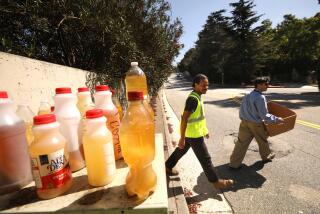Craig Rice
- Share via
On Nov. 15, the Coast Guard, acting on complaints from environmentalists, boarded a boat chartered by Rev. Craig Rice, who planned to dump 34,400 bottles stuffed with religious tracts into the Pacific. He was told that the law prohibits such action without a permit. Rice has been tossing bottles into the sea since 1967, letting the current carry them to distant lands.
Q: Can you define “bottle evangelism”? A: First, I’ll explain that I am founder of Current Evangelism Ministries, an interdenominational missionary ministry in Lodi, Calif. We place religious messages in bottles that are launched into the ocean. Then they float, carrying the word of Christianity to whomever the finder is. Q: What kinds of bottles make the best vessels? A: We use beer bottles, soda bottles, wine bottles--the smaller ones. Beer bottles are the most common because there’s a great volume of beer drunk. We get bottles from alongside the road and pick them out of Dumpsters.. We seem to float a lot of Bud and Coors. Q: What message is carried in your bottles? A: The Gospel of John. Besides that, we use other tracts--salvation leaflets and Sunday school literature--all in English. Sometimes I’ll put in extra booklets in four languages: Russian, simplified Chinese for Red China, Korean and Vietnamese. I try to cram them with as much as I can--I’d hate to have them float half-empty with such tremendous needs on the other side of the world. My bottles have landed in countries like New Guinea, Indonesia, Malaysia, the Philippines and a lot of the South Pacific islands like Guam and the Marshalls. I date the literature. The fastest one arrived in Majuro (in the Marshall Islands) in 18 months, but an average trip is two years. Q: Have your bottles ever been discovered on U.S. shores? A: No, they never come back. It’s because of the current. I wrote to Scripps Institution (of Oceanography at UC San Diego), and they said that any bottle dropped 50 miles out will stay out. So when I drop mine more than 200 miles out, they sweep down over the Equator to Asia and people find them there. Q: How many people does it take to assemble the bottles? A: It’s quite an operation. We have a few volunteers who bring in the bottles, and volunteers who supply literature. Some put the literature in the bottles and some cut the corks. Actually, all by myself I can do 12,000 bottles (a year) standing on my head--that’s not that many. Q: Can you describe your particular floating technique? A: First you go out your X number of miles. Then the boat slows down, and when the captain gives the green light, the crew starts throwing the bottles over. A bunch go over the left side, a bunch go over the right and a bunch over the tail. The bottles are in cardboard cases of 24. You just pick up the whole case and throw it over; the cardboard turns to mush and sinks. The boat is still moving, so if we start launching at the 200-mile mark we might not be finished until the 250-mile mark. Q: How frequent are your expeditions? A: We try to go out once a year, but we haven’t done it in three years. The captain of the boat I chartered had to use his boat for fishing. You know the fishing industry--the bottom’s falling out. I couldn’t find another captain; Christian fishermen with big boats are hard to find. We try to float as many bottles as we possibly can, but I’d say we now average about 12,000 a year. Q: After all these years, why do you think the Coast Guard took exception to this launching? A: That’s a good question. The Coast Guard came onto our boat and told us that if we dropped the bottles--even past the 200-mile mark into international waters--we would still be in their jurisdiction. (The Coast Guard maintains authority over any boat that leaves a U.S. port with the intention of dumping materials into the water.--Ed.) Also, they told us we needed a permit from the Environmental Protection Agency. We didn’t know that. We haven’t floated in three years, but I don’t know when all these rules and regulations came about. Q: Does your practic of bottle evangelism give some people cause to question your mental stability? A: Bottle evangelism is not something too many people do. But just because other people aren’t doing it doesn’t make me a kook. Q: What’s one of your favorite replies? A: There was one minister in the Philippines who lived on the island of Dinagat, where the people were Animists, which means they worship trees and rocks and stones. A bottle landed there, in May of 1980, and he said 70 people were converted to Christ because of it. We sent him 240 New Testaments in the Cebuano (CQ--LV) dialect.
More to Read
Sign up for Essential California
The most important California stories and recommendations in your inbox every morning.
You may occasionally receive promotional content from the Los Angeles Times.













